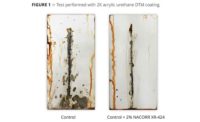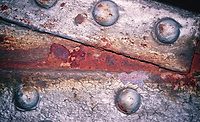Global corrosion costs are estimated to be in excess of 2.2 trillion dollars per annum, or over 3% of world GDP.1 This figure is no doubt growing year on year due to this silent killer. We are not winning the war on rust! Many mature paint technologies are often adequate in terms of their efficacy in corrosion resistance, but legislation has moved to remove them from the workplace or the environment due to their deleterious health or environmental effects. This is seen with the removal of lead-based paint2 through to chromates,3 and we see the potential removal of zinc dust and possibly all heavy metals from paints and coatings. A similar story is being played out with regard to antifouling coatings, with organotin additives being removed4 and with what appears to be moves to remove copper-based antifouling agents in the future.5 The challenge for researchers and formulators is to remove these materials from paints to meet the current health and environmental legislation while still developing products that maintain their corrosion-inhibiting properties.
To help with this we have to understand that corrosion inhibitors act in many different ways. For example, some inhibit the electrochemical reactions at the cathode (e.g. magnesium, zinc, nickel) and at the anode (e.g. nitrates, chromates, molybdates, phosphates, silicates), or use an organic material as a coordinating barrier (e.g. azoles, thiols, carboxylates).6 For formulators, these traditional anode and cathode inhibitor materials come in the form of pigments to be added to the paint formulation. However, organic materials are avoided due to their incompatibility with coatings, as they are potential curing agents.
How can these organic and organo-metallic materials be incorporated successfully without compromising the coating’s properties? How can we “compatibilize” these materials in the coating and have them be available to demonstrate their functionality when needed, but prevent them from interfering in the formulation or invalidating the properties of the coating itself? Can they maintain optical and physical properties and have corrosion control as good as the current standards or better? How do we control their release when and where they are needed? Can we have these materials act as soon as water enters a scratch? Can we do all this and meet our requirements for health, safety and the environment? Can we have self-healing coatings with smart pigments?
The answer to these questions is “yes”, by encapsulating corrosion inhibitors inside porous ceramic particles that will provide protection to the payload and sustained release of the corrosion inhibitors. Inhibispheres® are such controlled-release corrosion inhibitors (CRCI) - designed to work in all kinds of coatings to inhibit corrosion on aluminum and steel. These particles are not capsules, but have a matrix structure with the actives anchored inside the matrix pores, with loadings of actives typically 10-25% by weight. The particles are mechanically and chemically resistant. They can withstand grinding, milling and extrusion processes with no deleterious effects on the properties of either the particle, the active or the coating. The sequestration of the active inside the porous ceramic matrix enables the incorporation of actives that would normally be incompatible with the paint in their un-encapsulated form. The corrosion-inhibiting active is released in a controlled manner whenever water penetrates the coating due to immersion, condensation or mechanical damage. The actives come in a range of organic (metal-free system) and organo-metallic inhibitors specially tailored to the metal substrate and with a controlled and defined release rate for quick action on exposed surfaces or the extension of coating life when used either alone or in conjunction with traditional corrosion inhibitors (zinc dust/zinc phosphate). The materials come in a range of sizes from 100 nm-100 micron (Figure 1).
Formulation
The CRCI particles are easily incorporated into coatings of different chemistries (epoxies, alkyds, urethanes, powder coatings), including solventborne, waterborne and high solids. A typical application is a 2K epoxy coating. The CRCI particles are homogenously dispersed into the coating resin. There is no significant impact on mixing or viscosity of the mixture due to the addition of the CRCI smart pigments. The material acts as a normal pigment in its addition due to being silica based. A typical formulation is shown in Table 1. As the materials are a matrix, they can withstand a milling (or extrusion) step without premature release of the active; this is in contrast to traditional encapsulated technology (i.e. capsules), which will break open and prematurely release their payload under such conditions and as such must be formulated post processing in an extra step. The CRCI particles also allow for the formulation of corrosion-inhibiting actives that cannot normally be used in paint formulations because of their destabilization effect on the paint (e.g. hydrophobes in water-based paints) or by catalyzing the resin polymerization.
Application
The coating resin with the CRCI materials are typically sprayed with an HVLP gravity-feed system and applied on either aluminium Al2024-T3 bare, which has been chemically etched, or cold rolled mild steel EN1030, which has been sandblasted.7
The materials are homogenously dispersed through the coating after curing. The SEM of the coating layers show the inhibisphere materials evenly dispersed in the coating (Figure 2). The film thickness for aluminium is 20-25 micron, and for steel is 30-40 micron. While an air spray system has been used on the materials shown here, they can also be incorporated into brush, roller or powder coatings that are solvent based, water based, low VOC or high solids.
Characterization
Adhesion
The inclusion of the CRCI into the coating had no effect on the adhesion of the coating to the substrate. Testing of the material with crosshatch scribe according to ASTM D3359 gave no indication of any reduction in adhesion to the substrate surface due the presence of the matrix-encapsulated materials.8 This would be expected, as the matrix is essentially silica.
Gloss
The gloss of the coatings for the CRCI material was measured and compared against the coating without the CRCI as well as a coating containing the traditional inhibitor for steel, zinc phosphate (ZnPO4). The difference between the two materials and the minimal impact of the CRCI material in the coating is apparent on visual inspection. Gloss measurements of the coats were performed, with the results shown in Figure 3. The control coating and the CRCI-containing coating are very similar. They are within the margin of error of the measurements across the film. The ZnPO4 coating has a significantly low gloss value and could be classed as a matte finish. While the materials are capable of being used as a corrosion-control agent in a primer (substituting for ZnPO4), the advantage of the matrix-controlled release material is the potential for incorporation into a direct-to-metal (DTM) topcoat. This would add corrosion inhibition functionality to the topcoat. It would potentially reduce the need for two coats in a system by removing the primer and maintaining the gloss.
Controlled Release
Through careful manipulation of the chemistry of the pigment and the size of the pores in the particle, a tailored release profile can be achieved. Figure 4 shows the difference in release rates of an active based on the pore size of the particle matrix. This allows the active to be released quickly at the site of corrosion to stop it in its tracks, or released slowly to extend the life of the coating by giving corrosion prevention over a longer lifetime.
Corrosion Resistance
Neutral Salt Spray Test (NSST) on Aluminum
The CRCI materials were tested against a nonchromate inhibitor in the NSST. The active in the matrix is released into the scribe during testing by diffusion from the matrix and it preserves the shininess of the scribe as is seen with traditional chromate inhibitors. This shininess was preserved for just under 1000 hrs in NSST. The coatings themselves demonstrated similar performance to other nonchromate inhibitors shown to have an inhibitory effect on corrosion out to 4000 hrs. No blisters or corrosion products are seen in the scribe. The shiny scribe can be seen in comparison with the controls in Figure 5.
NSST on Steel
For steel, the controlled release of the actives can be seen in comparison with the traditional inhibitor. The 10% ZnPO4-containing coating on a panel of cold rolled steel EN10130 was found to provide as much corrosion inhibition control as 2% by weight of the CRCI material. The level of the active organic corrosion inhibitor inside the matrix material was 10%, which gives an actual loading of active corrosion inhibitor of only 0.2% by weight in the coating. The reduction in material allows for formulation with organic inhibitors at levels low enough to remove hazard labelling. The scraped steel plates can be seen in Figure 6.
Using a profilometer the depth of the scribe for the steel plates was measured after scrapping, once 1000 hrs in NSST was completed. The scribe depth measurement was used as a method of comparison between the traditional corrosion inhibitor (ZnPO4) and the CRCI material. The results can be seen in Figure 7 and it is obvious the CRCI material has significantly slowed or stopped the corrosion process in the scribe while both the control and the ZnPO4 sample have undergone significant corrosion in the scribe, as seen with an overall increase in scribe depth when compared to the CRCI sample.
Local Electrochemical Impedance Spectroscopy (LEIS) on Aluminum
LEIS was performed for each of the materials on the aluminium substrate Al2024-T3. The plots in Figure 8 show the self-healing effect demonstrated by the controlled release of the active from the matrix. The coatings without the CRCI show significant corrosion in the scribe over time - with more corrosion seen at 168 hrs immersion compared to the sample at 24 hrs. However, in the system with the CRCI, the admittance in the scratch is hardly seen at 24 hrs and only slightly more visible at 168 hrs. The admittance values for the CRCI sample are much lower than without by comparison. In addition to this, no corrosion was observed in the scribe of the sample with the matrix-encapsulated material. This result demonstrates the controlled release of the corrosion-inhibiting active from the matrix. Once in the scratch, the corrosion process is halted or significantly retarded.
Conclusions
It is possible to remove traditional inhibitors and incorporate smart pigment materials to give the same, if not a better, level of corrosion control in coatings. Moreover, these can also remove environmental, health and safety concerns due to heavy metals. Inhibispheres are shown to be a versatile and robust replacement for traditional corrosion inhibitors. They can be easily incorporated into water, solvent or powder coatings. They can be tailored to whatever conditions are required with control over particle size and active release rate. They have no significant impact on the final coating properties (optical and mechanical). The controlled release mechanism allows for the extension of coating life and the inhibition of corrosion directly in the scribe.
While the current application of this technology is in the area of corrosion inhibition for coatings, the matrix encapsulation technology can be applied to controlled release in antifouling, fire retardants, UV absorbers, etc. It also has applications in payload protection for healthcare, drug delivery, thermal stabilization of temperature-sensitive actives, etc.
By Andy Noble-Judge, Coating Formulation Specialist, and Christophe Barbé, Chief Technical Officer, Ceramisphere Pty Ltd., Sydney, Australia
References
1 Hays, G.F. Now is the Time, PE, Director General, World Corrosion Organization.
2 Gottesfeld, P. Time to Ban Lead in Industrial Paints and Coatings, Front. Public Health, 2015; 3: 144.
3 Chromium (VI) standard, 29 CFR 1910.1026.
4 Organotin Antifouling Paint Control (33 U.S.C. 2401) 1988.
5 Substitute Senate Bill 5436, Chapter 248, Laws of 2011, 62nd Legislature, 2011 Regular Session, Recreational Water Vessels--Antifouling Paints.
6 Dariva, C.G.; Galio, A.F. Corroision Inhibitors - Principles, Mechanisms and Applications, InTech, 2014, Chapter 16.
7 Preparation of Steel Substrates Before Application of Paints and Related Products - Visual Assessment of Surface Cleanliness, ISO 8501-1:2007.
8 ASTM D 3359 Standard Test Methods for Measuring Adhesion by Tape Test.
9 da Silva, C.; Barbe, C.; Campazzi, E.; Lathiere, P.J.; Pebere, N.; Rumeau, E.; Tran, L.; Villate, M. LEIS to Study Corrosion Protection of AA2024 by Smart Coatings Containing Encapsulated Inhibitors, Proceedings of the 10th Symposium on Electrochemical Methods in Corrosion Research, Maragogi, Brazil, 2012.














Report Abusive Comment